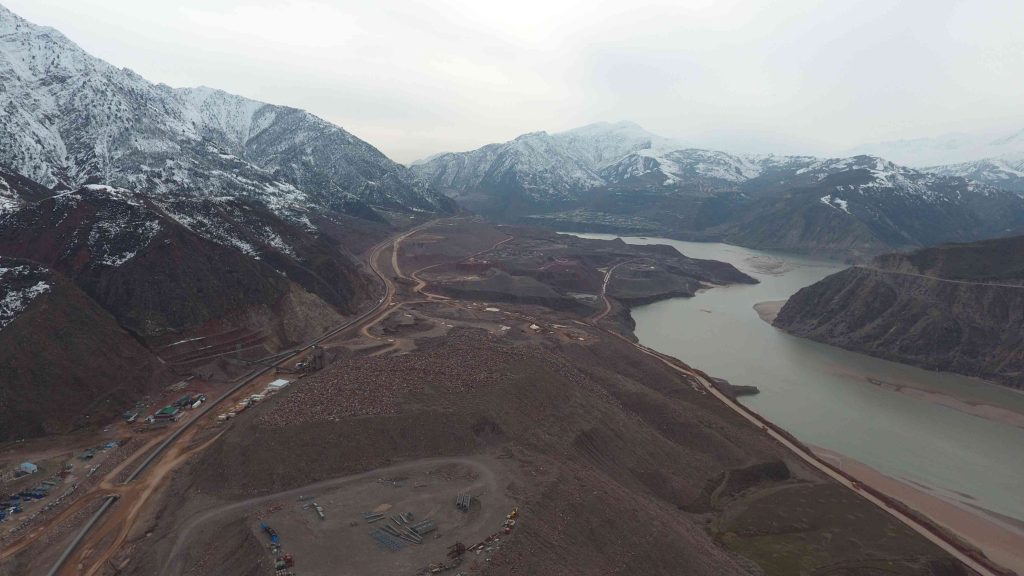The proposed Rogun Hydropower Project in Tajikistan is set to displace 69 villages, uprooting 60,000[1] individuals from their homes and livelihoods according to the project’s Resettlement and Livelihood Restoration Framework. The number of affected people is likely to be even higher as the document fails to specify the number of affected villages who will suffer from the project’s other impacts, e.g., income loss due to flooding of agricultural lands. The experiences of the 7,297 people that have already been resettled between 2009-2014 for the construction of the lower dam paint a grim picture of what lies ahead for those still awaiting relocation.
A Troubling History of Resettlement Failures
According to Human Rights Watch, the initial phase of resettlement, between 2009 and 2014, was marked by significant failures that left many of the resettled families in vulnerable and precarious situations, drastically reducing their quality of life. Families who were relocated faced a sharp decline in living standards. Many lost their land for farming and livestock, their primary means of subsistence, and found themselves without adequate employment opportunities. Access to essential services like healthcare and education was severely limited in the resettlement areas, further exacerbating their hardships.
The Harsh Realities of Resettlement:
- Inadequate Housing and Compensation: Although land was allocated to resettled families, houses were often not built on these plots. Compensation based on “market value” was frequently insufficient to cover the costs of constructing a new home, let alone hiring qualified workers. Moreover, there were significant delays between the assessment of compensation and its actual distribution, leaving families in limbo for extended periods.
- Insufficient Land for Farming: The plots of land provided were just large enough to build a house but insufficient for farming. Families who once grew most of their own food were now forced to buy it, straining their already limited financial resources.
- Unfulfilled Promises of Employment: Despite assurances that jobs would be available in the new villages, 67 of the 83 resettled individuals interviewed by Human Rights Watch remain unemployed. This lack of economic opportunity has plunged many families into poverty.
- Water Shortages and Lack of Basic Infrastructure: In the resettled villages, water shortages are common, making it difficult for families to grow food or even perform basic household tasks. In some cases, people have to walk several kilometers just to fetch water. Furthermore, many communities have been without a local school for years, depriving children of their right to education.
A Grim Outlook for the Future
Given the failures of the previous resettlement process, it is highly unlikely that the upcoming resettlement phases will be managed any better. The families are still waiting for adequate compensation and support, and there is little reason to believe that the current plans for resettlement will avoid repeating the same tragic mistakes. An analysis of the Resettlement and Livelihood Restoration Framework (RLRF) intended to guide this process offers little hope for improvement. Instead of addressing the shortcomings of the previous efforts, the RLRF is riddled with gaps and ambiguities, raising serious concerns about its effectiveness and the likelihood of avoiding further humanitarian failures.
Huge Gaps in the Resettlement and Livelihood Restoration Framework (RLRF) Document
- Gender-Related Risks for Land-to-Land Compensation: The RLRF superficially addresses the gender-related risks inherent in land-to-land compensation, but it fails to provide clear mechanisms to protect vulnerable women. Only about half of women have some ownership rights to housing, and less than 1 percent are sole owners. Furthermore, women’s rights can often be informal, especially in cases of unregistered marriages, unformalized divorces, or when husbands are working overseas. The lack of clarity around ownership leaves many women in precarious situations in the process of land-to-land compensations.
- Standards for Involuntary Resettlements: Although land is promised for new housing, the responsibility for construction falls on the resettled families. The only concrete standard provided is a minimum living space of 12m² per person, with no further guidelines on house quality or design. Public facilities are required to be accessible for people with disabilities, but no specific standards are mentioned, raising concerns about the inclusivity of the resettlement plans.
- Effects on Non-Resettled Populations: Perhaps most alarming is the RLRF’s complete neglect of the impacts on populations who will not be resettled but will continue to live in proximity to the dam. These people are also likely to face significant economic dislocation, yet no efforts have been made to calculate how many people will be economically displaced or what compensation they may receive. Downstream populations, including 10 million people who depend on the river’s flow, are particularly vulnerable. Despite the Environmental and Social Impact Assessment’s (ESIA) claims of including mitigation measures, there is an absence of any studies on the environmental changes downstream and their consequences on the people reliant on this water source.
Resettlement Accepted Despite Feasible Alternatives
The resettlement of thousands of people is being justified by the World Bank on the grounds that the overall benefits of the Rogun Hydropower Project will outweigh the negative impacts of displacement. However, the bank’s Environmental and Social Impact Assessment reveal that a smaller dam, with a dam height of 300 instead of 335 meters, could meet nearly all of the project’s objectives while reducing the resettled population to under 20,000— less than a third of those currently scheduled for resettlement. Opting for the larger dam, which would result in nearly three times the number of resettlements, directly contravenes the World Bank’s Environmental and Social Standard 5 (ESS5). ESS5 is founded on the principle of “Avoidance,” which seeks to minimize resettlement wherever possible. The decision to proceed with the larger dam, therefore, represents a significant deviation from the bank’s own policies and raises serious concerns about the commitment to minimizing harm to affected communities.
[1] The document estimates that 50,267 individuals will be resettled; however, it states that this number is likely to increase to 60,000 by the time of resettlement due to population growth.



